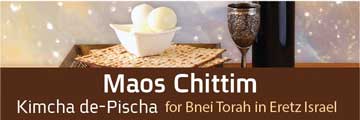Definitions
1. What is the halachic definition of a fruit tree?
Regarding the b’racha borei pri ha’eitz, a fruit tree is defined as one whose trunk remains from year to year. If only the roots remain, the produce of such a plant is considered a vegetable according to most opinions and requires the b’racha borei pri ha’adama. E.g. strawberry. See also question 10.
2. Don’t bananas and pineapples grow on trees?
The banana plant is not considered a tree, because it has no real trunk. The central stem is simply a mass of leaves from which the bananas grow, but dies after supplying its crop. Since no more than the root system survives, it is halachically equivalent to the strawberry and therefore requires the b’racha ha’adama. Pineapples grow in a similar way.
3. Is papaya a fruit?
The papaya is subject to controversy. Although the trunk survives from year to year, the tree has features resembling a vegetable. For example, it produces fruit within a year of planting and its trunk is hollow, both of which are not typical of a tree. According to most opinions, the b’racha is ha’adama. See also question 9.
4. Is a shrub considered a tree?
Strictly speaking, a shrub fulfills the requirements of a tree and its fruit requires the b’racha ha’eitz. However, the widespread custom is to recite ha’adama if the shrub is lower than three tefachim (24cm). Therefore:
- Blackberries, blueberries, and gooseberries, require ha’eitz.
- Cranberries require ha’adama.
5. What is the b’racha for raspberries?
Opinions differ whether this is considered a tree, since it grows differently from other types of shrubs. Due to the doubt, one should recite ha’adama.
6. Which other species are sometimes mistaken by people?
- Avocado, kiwi, sabra, and all nuts except peanuts require ha’eitz.
- Cantaloupe melon, watermelon, peanuts, and sunflower seeds require ha’adama.
- Mushrooms require shehakol (see question 12).
7. What if one recited the wrong b’racha for a fruit or vegetable?
- If one recited ha’adama instead of ha’eitz, the b’racha is valid and should not be repeated.
- If one recited ha’eitz instead of ha’adama, the b’racha is not valid. He must say baruch sheim etc. and recite the correct b’rachaha’adama
8. What is the reason for this distinction?
- To describe a fruit as produce of the ground (pri ha’adama) is true, and although ha’eitz is the preferred b’racha, ha’adama is valid.
- To describe a vegetable as produce of the tree (pri ha’eitz) is not true, and therefore the b’racha is not valid.
9. What if one recited ha’eitz for papaya?
Since opinions differ regarding the b’racha for papaya, it is possible that ha’eitz is valid. Therefore, he should eat no more than a tiny amount and then recite ha’adama on a true vegetable before continuing with the papaya. The same applies to raspberry.
10. What if one recited ha’eitz for a strawberry?
Although this is the wrong b’racha according to most opinions, it is valid according to a minority opinion. Therefore, one should eat a tiny amount and recite ha’adama on a true vegetable before continuing with the strawberry. The same applies to banana and pineapple.
11.What if one cannot determine the correct b’racha for a fruit?
He should recite ha’adama.
12. What is the correct b’racha for mushrooms?
Shehakol. Mushrooms draw their main nourishment from moisture in the air and therefore they are not considered a produce of the ground.
13. What if one recited ha’adama?
The b’racha is valid, since mushrooms do benefit from moisture in the ground.
14. Is the regular b’racha required for fruits and vegetables grown in plant pots?
According to most opinions, the regular b’racha is required.
15. What is the b’racha for hydroponically grown vegetables?
According to most opinions, the b’racha is shehakol.
16. What is the b’racha for sprouts?
Since sprouts are usually grown in water, the b’racha is shehakol.
Unripe
17. Is the regular b’racha required for unripe fruits and vegetables?
No. The b’racha for unripe fruits and vegetables is one level lower than the regular b’racha. Therefore, unripe fruits require ha’adama and unripe vegetables require shehakol, e.g. a green banana or tomato.
18. What if one recited the regular b’racha?
The b’racha is valid.
19. When is a fruit or vegetable considered sufficiently ripe?
Opinions differ regarding the stage of ripeness required in order to recite the regular b’racha. In practice, the guideline is whether most people would be prepared to eat it in normal circumstances. If there is any doubt whether it has reached this point, one should recite the lower b’racha.
20. What if a bunch of grapes has a few small ones?
Unripe grapes require ha’adama. However, if a bunch of ripe grapes has a few small ones, they are also usually ripe and the b’racha ha’eitz includes all of them.
21. What is the b’racha for sour oranges at the start of the season?
The b’racha is ha’eitz, since most people will eat them.
Raw and Cooked
22. Do cooked fruits and vegetables retain their b’racha?
The regular b’racha for fruits and vegetables is required only when they are eaten in the normal way. If one eats them in an unusual form, he must recite the b’racha shehakol. Therefore:
- If a fruit or vegetable is usually only eaten raw, the b’racha shehakol is required when eaten cooked.
- If it is usually only eaten cooked, the b’racha shehakol is required when eaten raw.
- If it is eaten both raw and cooked, the regular b’racha is required for either form.
23. What if one recited the regular b’racha instead of shehakol?
The b’racha is valid.
24. What are common examples?
- Avocado, bananas, cucumbers, grapes, and melons are usually only eaten raw. If they were cooked, the b’racha would be shehakol.
- Beets, chestnuts, peanuts, and quince are usually only eaten cooked or roasted. If they are eaten raw, the b’racha is shehakol.
- Most fruits and vegetables are commonly eaten both raw and cooked. For example, apples, cabbage, pears, pepper.
25. What if habits differ from one country to another?
The rules are based on the common practice in each country. For example, fresh green peas and beans in their pods are eaten raw in America, and the b’racha there is ha’adama. In many other countries, such as Eretz Yisroel (as of the time of writing), they are not usually eaten raw, and the b’racha there is shehakol. Similarly, peanuts are eaten raw in England, and the b’racha there is ha’adama, but in Eretz Yisroel they are only eaten after roasting.
26. What should one do when visiting a country with a different habit?
He should retain his own home custom. For example, a visitor to Eretz Yisroel from America should recite ha’adama for raw peas and beans. If he settles in another country, he should follow the local custom.
27. What is the b’racha for esrog?
- Most esrogim are too sour to be eaten raw and the b’racha would be shehakol. Cooked esrog (preserves, jam) and candied esrog are ha’eitz.
- Yemenite esrogim are edible raw and their b’racha is ha’eitz.
Condiments
28. What is the b’racha for a raw onion?
Although onions are commonly eaten raw, they are generally only eaten this way as an accompaniment to other foods, e.g. in a salad. In that case, the onions are tafel and require no b’racha. If one eats a raw onion alone, the b’racha is shehakol, and the same applies to boiled onions. The b’racha ha’adama is only recited for fried onions, which are sometimes eaten alone in this form.
29. What is the b’racha for raw garlic?
The rules for garlic are the same as for onion. Therefore, raw or boiled garlic requires shehakol, and only fried garlic requires ha’adama.
30. What are other examples of this rule?
Horseradish (chrain) is not usually eaten alone, but as an enhancer to other foods. If eaten alone, the b’racha shehakol is required. Similarly, green vegetables that are used primarily to flavor soups require shehakol if eaten alone, e.g. parsley, dill.
31. What is the b’racha for scallions?
- In countries where they are eaten alone, the b’racha is ha’adama.
- In countries where they are usually only eaten in salads, the b’racha is shehakol when eaten alone.
32. What is the b’racha for a lemon?
Shehakol. Lemons are not usually eaten alone, but are used as a flavoring for other foods, or to produce lemon juice.
33. What if one recited the regular b’racha instead of shehakol?
The b’racha is valid for any of the examples in this section.
Mashed and Ground
34. Do mashed fruits and vegetables retain their b’racha?
When fruits and vegetables are mashed, chopped, grated or pureed to the extent that they are no longer recognizable, the b’racha changes to shehakol. This applies to both raw and cooked foods.
Note: The five principal grains and rice are exceptions to this rule and their b’racha is mezonos when cooked, even if they have completely lost their original form.
35. What if one recited the regular b’racha instead of shehakol?
The b’racha is valid.
36. How does one determine whether it is recognizable?
If one is unsure whether it is recognizable, he should show it to another person. If the other person can identify the food, the regular b’racha should be recited, but if he cannot identify it or he is unsure, the b’racha is shehakol.
37. Which common mashed foods retain their b’racha?
- Mashed avocado, banana, eggplant, and potatoes retain their b’racha, since they each have a distinctive texture and appearance.
- Mashed cooked carrots, tomato paste, and pureed fruits and vegetables (such as baby foods), are usually not recognizable and their b’racha is shehakol.
38. Which common mashed foods retain their b’racha?
Yes. Even if the ingredients are no longer recognizable, nevertheless the b’racha is ha’adama since the eggplant could be identified when alone. The fact that it was mixed with another food is not a reason to change its b’racha. The same applies to any similar case; e.g. mashed avocado mixed with chopped eggs and mayonnaise retains the b’racha ha’eitz, even if the avocado is not recognizable.
39. Is potato puree considered recognizable?
Yes. In contrast to other vegetables which lose their appearance when pureed or blended and require shehakol, potatoes retain their unique texture and the b’racha remains ha’adama (see also question 46).
40. What is the b’racha for reconstituted instant potatoes?
Ha’adama. Although the dehydrated powder does not look like potatoes, nevertheless the reconstituted product is recognizable.
41. What is the b’racha for apple sauce?
- If the apples are thoroughly mashed, strained, or pureed into a smooth paste, the b’racha is shehakol.
- If the apples are not completely mashed and there remain pieces or strands of fruit, the b’racha is ha’eitz.
Note: The criterion is the appearance and texture of the sauce and not whether it is commercial or home-made.
42. What is the b’racha for jam?
- If the jam contains identifiable pieces of fruit, the b’racha is that of the fruit (ha’eitz/ha’adama).
- If the fruit is not recognizable, the b’racha is shehakol.
43. Must one be able to identify which fruit it is?
Yes. If one can recognize pieces of fruit in the jam but cannot identify which fruit, the b’racha is shehakol.
44. Are strawberry seeds sufficient identification?
No. If the strawberries in the jam have totally lost their appearance, the b’racha is shehakol even though the seeds reveal the identity of the fruit.
Note: Identification through seeds is sufficient for raw mashed strawberries, but not for jam in which the strawberries underwent a further change through cooking.
45. What are common examples of grated or chopped fruits or vegetables?
- Most fruits and vegetables retain their appearance when grated or chopped even finely. Therefore, the original b’racha is recited.
- Desiccated coconut is not recognizable, and its b’racha is shehakol. Therefore, snack bars containing desiccated coconut and Pesach cookies made from ground coconut require shehakol.
- Foods made from potato flour/starch, corn flour, etc. require shehakol, since the vegetable is no longer recognizable after being ground into flour.
- Foods made from processed soya beans or tofu are shehakol, since the beans have been altered beyond recognition.
46. What is the b’racha for potato kugel or latkes?
47. What is the b’racha for vegetable kugel or latkes?
The b’racha depends on whether the vegetables are still recognizable. As noted above, vegetables lose their appearance more easily than potatoes.
48. What is the b’racha for peanut butter?
Shehakol. This applies even to the crunchy variety that contains bits of peanuts, unless the pieces are recognizable.
49. What if a vegetable loses its appearance by other means?
The b’racha ha’adama is retained, providing the vegetable is still intact. The loss of appearance is not a sufficient reason to change the b’racha to shehakol, unless the vegetable has become unrecognizable through a process such as cooking or grinding.
50. What are examples of this rule?
Potato chips and popcorn are ha’adama.
51. Does this apply to chips from dehydrated potatoes?
No. According to most opinions, the b’racha is shehakol, e.g. Pringles.
52. What is the b’racha for cornflakes?
- If they are made from rolled kernels of corn, the b’racha is ha’adama. For example, Kellogs, B&D, Post.
- If they are made from corn flour, the b’racha is shehakol. For example, Telma, General Mills, Total.
53. What if one does not know how they were made?
He should recite shehakol.
Seeds and Peels
54. What is the b’racha for edible pits and seeds?
- If one also eats the fruit or vegetable, the pits and seeds are tafel and do not require a b’racha.
- If one only eats the pits or seeds, the b’racha is one level lower than usual, i.e. ha’adama for fruits, shehakol for vegetables.
- If the plant is grown specifically for its pits or seeds, the regular b’racha should be recited.
55. What are examples of these rules?55.
- Sunflower seeds are ha’adama.
- Watermelon and pumpkin pits sold in stores in Eretz Yisroel are ha’adama. Pits of regular watermelons and pumpkins are shehakol.
- Sesame seeds are ha’adama.
- Flax seeds are shehakol.
56. What is the b’racha for products made from sesame seeds?
- If the seeds are recognizable, the b’racha is ha’adama, e.g. sesame snack bars.
- If the seeds are not recognizable, the b’racha is shehakol, e.g. halva.
57. What is the b’racha for fruit peels?
- The b’racha for peels that are usually eaten is ha’eitz, e.g. apple.
- The b’racha for peels that are not usually eaten is shehakol. Even if they have been processed by cooking or by being candied, theb’racha remains shehakol, e.g. orange.
- Candied esrog peel is an exception, and the b’racha is ha’eitz (see question 27).










